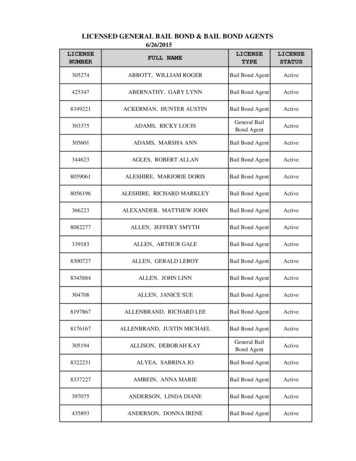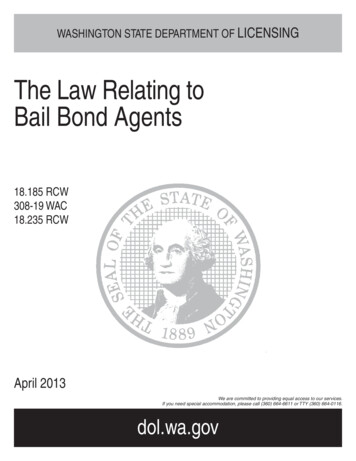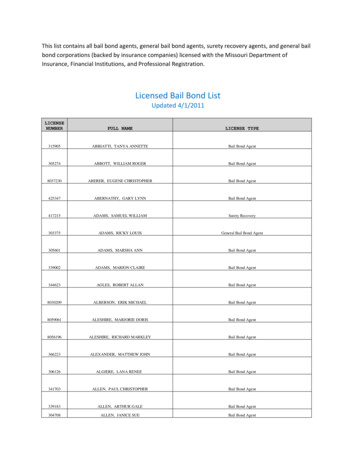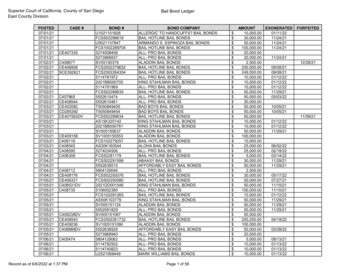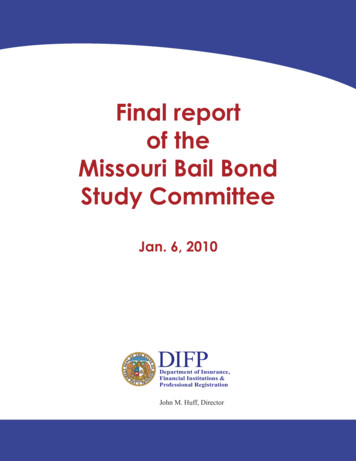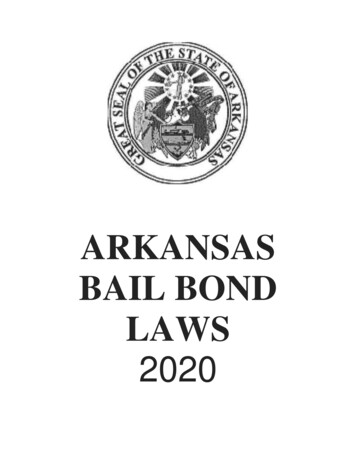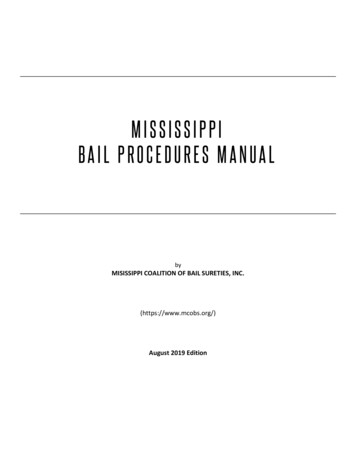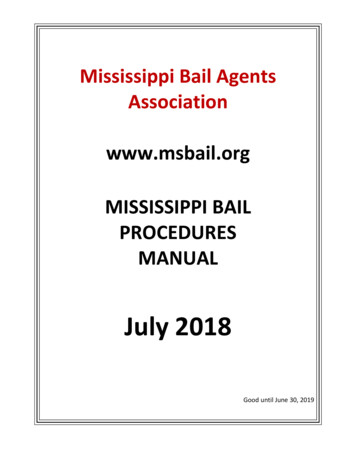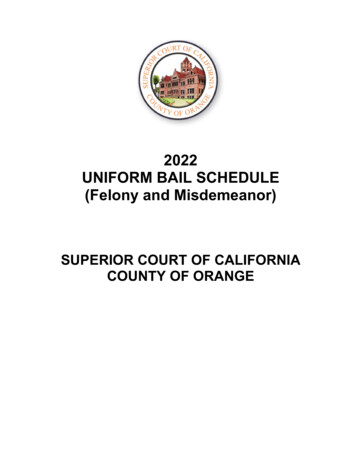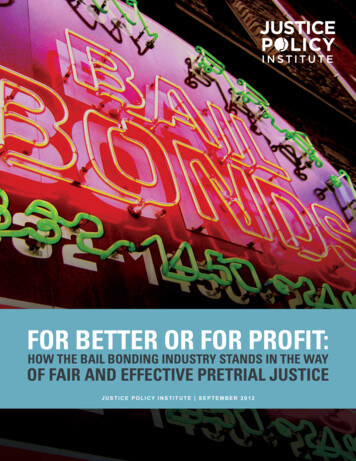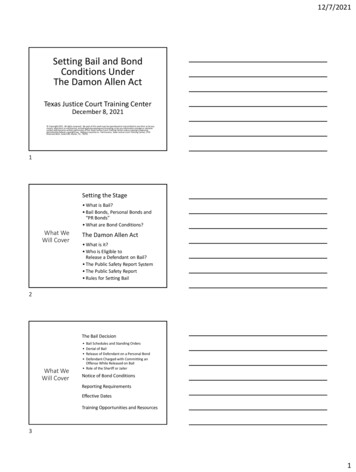
Transcription
12/7/2021Setting Bail and BondConditions UnderThe Damon Allen ActTexas Justice Court Training CenterDecember 8, 2021 Copyright 2021. All rights reserved. No part of this work may be reproduced or transmitted in any form or by anymeans, electronic or mechanical, including photocopying and recording, or by any information storage or retrievalsystem without prior written permission of the Texas Justice Court Training Center unless copying is expresslypermitted by federal copyright law. Address inquiries to: Permissions, Texas Justice Court Training Center, 1701Directors Blvd., Suite 530, Austin, TX, 78701.1Setting the Stage What is Bail? Bail Bonds, Personal Bonds and“PR Bonds” What are Bond Conditions?What WeWill CoverThe Damon Allen Act What is it? Who is Eligible toRelease a Defendant on Bail? The Public Safety Report System The Public Safety Report Rules for Setting Bail2The Bail Decision What WeWill CoverBail Schedules and Standing OrdersDenial of BailRelease of Defendant on a Personal BondDefendant Charged with Committing anOffense While Released on Bail Role of the Sheriff or JailerNotice of Bond ConditionsReporting RequirementsEffective DatesTraining Opportunities and Resources31
12/7/2021SETTING THE STAGE4 Bail is the security that a defendant puts up tomake sure they show up for future courthearings and their trial. If they fail to show up, they may forfeit thebail in a bail forfeiture proceeding.What is Bail?-- Art. 17.01, CCP; MagistrationDeskbook, Chapter 2.D.5The Purpose of Bail Setting bail has three general objectives: Ensuring that the defendant appears in court as directed; Protecting the safety of the victim of the offense and the generalsafety of law enforcement and the community; Releasing the defendant from custody. The purpose of bail is not to impose anadditional punishment for an alleged offense!62
12/7/2021What is a BailBond? A bail bond is a writtenundertaking entered into bythe defendant and thedefendant’s sureties for theappearance of the defendantbefore a court or magistrate toanswer a criminal accusation. The surety is typically a bail bondsman. If the defendant fails to appear for a hearingor trial, the surety is liable for the amount ofthe bond.7What is a BailBond? A defendant who is ordered topost a bail bond to be releasedfrom custody may also depositcash in the amount of the bailand in that case is not requiredto have a surety co-sign thebond. A magistrate may not require adefendant to post a cash bondunless the defendant has beenre-arrested after already failingto appear on the original bond orin a surety surrender situation.8What is aPersonalBond? A personal bond means that thedefendant is promising to pay theamount of the bail if they don’tshow up. But they are not required to have asurety co-sign the bond. So if bail is set at 5,000 and the defendant isallowed to sign a personal bond rather than a bailbond, and the defendant does not show up forcourt, the defendant is liable for the 5,000 in abail forfeiture proceeding.93
12/7/2021What is aPR Bond? The term “PR Bond” or “PersonalRecognizance Bond” is neverused in Article 17 or any otherstatute! But it generally refers to a personal bond withno bail amount. The defendant promises to showup as a condition of beingreleased but they are not liablein a bail forfeiture proceedingunder Chapter 22.10What is aPR Bond? But failing to appear on any bond, including aPR bond, is a criminal offense under PenalCode Sec. 38.10 (“Failure to Appear; BailJumping”). So a defendant who fails to appear aftersigning a “PR Bond” could be charged with anew criminal offense for that failure.11 Many people (including judges) mistakenlycall all personal bonds “PR Bonds.”What is a“PR Bond”? This is incorrect: if thebond has a monetaryamount the defendantagrees to pay if they fail toappear, then it is apersonal bond; if there isno monetary amount, thenit is a “PR Bond.”124
12/7/2021What is a“PR Bond”? “PR Bonds” are generally used only in fineonly and other minor misdemeanor caseswhile personal bonds may be appropriate inother cases as well.13Who Decides WhatKind of Bond isRequired? The magistrate orjudge who sets bailalso decides whetherthe bond must be abail bond, a personalbond or a “PR Bond.”14What are BondConditions?Bond conditions arespecific obligationsincluded as terms ofthe bond thedefendant signs andthat the defendantmust meet as acondition of theirrelease from custody.155
12/7/2021A magistrate may imposeany reasonable condition ofbond related to the safety ofa victim or the community.What are BondConditions?-- Art. 17.40(a), CCPFor example:Ignition Interlock DeviceNo contact with thevictimDrug testing16 Which of the following are NOT properobjectives of bail:A. Ensuring that the defendant showsup for court hearings and trial.B. Releasing the defendant fromcustody.C. Imposing an additional punishmenton the defendant.D. Protecting the victim, lawenforcement and the community.E. Sending a message to the public.Poll17Poll A “PR Bond” is:A. The same thing as a Personal Bond.B. Any bond that is not a Bail Bond.C. A Personal Bond in which no bail isrequired.186
12/7/2021Poll Bond conditions may only be used witha Bail Bond; they cannot be included ina Personal Bond.A. TrueB. False19THE DAMON ALLEN ACT20What is theDamon AllenAct? Reforms the bail system inTexas by giving magistratesbetter information about adefendant, including theircriminal record history, inorder to be able todistinguish between thosedefendants:217
12/7/2021What is theDamon AllenAct? who may be released ona personal bond, with orwithout bond conditions,and those who may not be releasedon a personal bond dueto a violent offense or anew offense whilereleased on bail for aprevious violent offense.22WhotoRelease aDefendanton Bail? A defendant charged with a felony ormisdemeanor punishable byconfinement may only be released onbail by a magistrate who is incompliance with the trainingrequirements in Arts. 17.024 and17.0501 (discussed on next two slides).-- Art. 17.023, CCP23What are theTrainingRequirements? OCA must develop trainingcourses concerning a magistrate’sduties with respect to setting bailin criminal cases, including: An 8-hour initial trainingcourse that includes training byDPS on the use of CJIS/CCH inorder to obtain criminal historyrecord information; and A 2-hour continuing educationcourse every two years.248
12/7/2021What are theTrainingRequirements? OCA must provide a method ofcertifying that a magistrate hassuccessfully completed the trainingcourse and demonstratedcompetency of the course content. A magistrate must complete the 8hour course within 90 days of takingoffice. But a magistrate who is serving on 4/1/22 has until12/1/22 to complete the course. Art. 17.024, CCP25The PublicSafety ReportSystem OCA must develop and maintain aPublic Safety Report System whichmust provide: Information on the eligibility of the defendant for apersonal bond. Information on the applicability of any required ordiscretionary bond conditions. The criminal history of the defendant in summaryform, including:26Previous misdemeanor or felonyconvictions.Pending charges.The PublicSafety ReportSystemPrevious sentences imposingconfinement.Previous convictions or pendingcharges for violent offenses (includingviolence directed to a peace officer).Previous failures of the defendant toappear in court following release onbail.279
12/7/2021OCA must provide access to the Systemto the appropriate county officials at nocost.The PublicSafetyReportSystemThe System may not: Be the only item relied upon by amagistrate in making a bail decision. Include a score, rating orassessment of a defendant’s risk. Make any recommendation for theappropriate bail for the defendant. Include information not in thestatute.-- Art. 17.021, CCP28The PublicSafetyReportA public safety report must beprepared for a defendant chargedwith a Class B misdemeanor orhigher level offense using thePublic Safety Report System.The magistrate must consider thereport before setting bail.And submit a bail form to OCA nolater than 72 hours after bail is set(see Handout 1).29The PublicSafetyReportA magistrate may, but is not requiredto, prepare or consider a report for adefendant charged with a fine onlyoffense or who receives a citationunder Art. 14.06(c).A magistrate may set bail for adefendant charged only with amisdemeanor without preparing orconsidering a report if the PublicSafety Report System is unavailablefor more than 12 hours due to atechnical failure at OCA.3010
12/7/2021WhoPrepares theReport? A magistrate may personally prepare thereport before or while making a bail decisionusing the Public Safety Report System.31Who Preparesthe Report? Otherwise, the magistrate mustorder a personal bond office orsuitably trained personnel(including judicial personnel orsheriff’s office personnel) toprepare the report and provide itto the magistrate no more than 48hours after the defendant’s arrest. The magistrate may not order the sheriff’s officeto prepare the report without their consent.-- Art. 17.022, CCP32Poll The purpose of the Damon Allen Act is:A. To keep more people incarcerated in jail while awaitingtrial.B. To give magistrates better information, including thedefendant’s criminal record history, so they can make aninformed decision about which defendants may be releasedon a personal bond with appropriate bond conditions andwhich defendants may not be released on a personal bond.3311
12/7/2021Poll Under the Damon Allen Act, a magistrate who is in office on April 1,2022 must obtain 8 hours of training on magistration:A. Before April 1, 2022.B. No more than 90 days after April 1, 2022.C. By December 1, 2022.34Poll Before setting bail a magistrate must consider a Public Safety Report:A. For every defendant.B. For a defendant charged with a Class Bmisdemeanor or higher offense.35Poll If a magistrate doesn’t want to prepare aPublic Safety Report themselves, they canalways order the Sheriff to prepare it forthem:A. TrueB. False3612
12/7/2021Rules for Setting Bail Bail and bond conditions must be set under the following rules in Art.17.15(a): The nature of the offense must be considered,including whether it involved violence underArt. 17.03 or violence against a peace officer. The ability to make bail must be consideredand proof may be taken on this point. The future safety of the community, lawenforcement and a victim are to beconsidered.37for Setting Bail The criminal history record information for thedefendant must be considered, including: Information maintained by DPS in CJIS/CCH and in the Public Safety Report System(not required until 4/1/22). Any acts of family violence. Other pending criminal charges. Any instances in which the defendant failed to appear in court after release on bail. The citizenship status of the defendant.38The BailDecision After individualized consideration of all thefactors listed in Art. 17.15(a), the magistratemust order that the defendant be: Granted a personal bond with or withoutconditions; Granted a bail bond with or withoutconditions; or Denied bail under the Texas Constitutionand other law. This order must be made without unnecessarydelay but no later than 48 hours after thedefendant is arrested.3913
12/7/2021The BailDecision In setting bail the magistrate mustimpose the least restrictiveconditions, if any, and the personalbond or bail bond necessary toreasonably ensure the defendant’sappearance in court and the safetyof the community, law enforcementand the victim.40The BailDecisionThe rules for settingbail do not require amagistrate to conductan evidentiary hearingunless required bysome other law.-- Art. 17.028, CCP41The BailDecisionA magistrate maymake a bail decisionfor a defendantcharged with a fineonly offense withoutconsidering thecriminal historyrecord information ofthe defendant. -- Art. 17.028, CCP4214
12/7/2021Bail SchedulesandStanding Orders A judge may not adopt a bailschedule or a standing orderthat is inconsistent withthese requirements orauthorizes a magistrate tomake a bail decision withoutconsidering each factor listedin Art. 17.15(a).43BailSchedulesandStandingOrders A defendant charged with a Class B or higheroffense who is unable to give bail in the amountrequired by a bail schedule or standing ordermust be provided with an opportunity to file anaffidavit stating that they do not have the meansto pay and requesting that an appropriatebail be set.44A defendant who files anaffidavit must complete afinancial information form.AffidavitConcerningBail Amount Same form for appointment ofcounsel or a form created by OCA.The magistrate must inform thedefendant of their right to file anaffidavit and ensure the defendantreceives reasonable assistance incompleting it and the financialinformation form.4515
12/7/2021A defendant may file an affidavit atany time during the bail proceeding.Review ofAffidavitThe defendant is entitled to a promptreview by the magistrate on the bailamount.The review may be conducted by themagistrate making the bail decisionor may occur as a separate pretrialproceeding.46The magistrate must considerthe facts presented and thefactors in Art. 17.15(a) and mustset the bail.Review ofAffidavitIf the magistrate does not setthe defendant’s bail below theamount required by a bailschedule or standing order themagistrate must issue writtenfindings of fact supporting thebail decision.47Failure toConductReviewwithin 48HoursIf a magistrate or criminal trialjudge does not conduct a reviewwithin 48 hours after thedefendant’s arrest, they mustreport that to OCA.If a delay occurs that will causethe review to be held more than48 hours after the defendant’sarrest, notice of the delay mustbe given to the defendant’scounsel or to the defendant ifhe does not have counsel.4816
12/7/2021If Defendant isNot Capableof Executingan Affidavit A magistrate may enteran order or take otheraction under Art. 16.22for a defendant whodoes not appearcapable of executing anaffidavit.-- Art. 17.028, CCP49Poll In setting bail and bond conditions, a magistrateshould:A. Set the most restrictive conditions possible to make sure the defendant showsup for court hearings and trial.B. Set the least restrictive conditions, if any, and the personal bond or bail bondnecessary to reasonably ensure the defendant’s appearance in court and thesafety of the community, law enforcement and the victim.50Poll A magistrate is required to give a defendant an evidentiary hearingon the bail decision if the defendant or defense counsel request one: A. True B. False5117
12/7/2021Poll If bail is set using a bail schedule or a standing order, the defendanthas a right to file an affidavit stating that they cannot pay the amountnecessary to make bail and asking for a new bail amount to be set:A. TrueB. False52 In most cases, a defendant may bedenied bail only by a districtjudge, and only in specifiedsituations.Denial of Bail Bail may also be denied by a judgeor magistrate where a defendantcharged with family violenceviolates a bond condition relatingto the safety of the victim or thecommunity.-- See Handout 253Denial of Bail Bail may also be denied by a judgeor magistrate where a defendantcharged with certain felonyoffenses against a child youngerthan 14 violates a bond conditionrelating to the safety of the victimor the community.-- See Handout 25418
12/7/2021 Defendants who are already onprobation or parole and are beingarrested for violations of those may bedenied bail on request from the trialjudge until they are brought beforethat judge.Denial of Bail Defendants who are wanted for paroleviolations from another state aresubject to the Interstate Compact onAdult Offender Supervision and maybe denied bail as well. See Magistration Deskbook; Self-pacedModule on Extradition and Fugitives fromJustice55Relenton a PersonalBond56Release ofDefendanton a PersonalBond5719
12/7/2021DefendantCharged withCommitting anOffense Whileon Bail If a defendant is chargedwith committing a felonywhile released on bail foranother felony, specialrules apply (see next twoSlides).DefendantCharged withCommitting anOffense Whileon Bail If the new offense wascommitted in the same countyas the previous offense, thenthe defendant may be releasedon bail only by: The court before whom theprevious offense is pending;or Another court designated inwriting by the court wherethe offense is pending.5859DefendantCharged withCommitting anOffense Whileon Bail If the new offense was committedin a different county as theprevious offense, then: electronic notice of the chargemust be promptly given to thecourt before whom theprevious offense is pending oranother court designated bythat court for purposes of re-evaluatingthe bail decision, determiningwhether any bail conditionswere violated or taking anyother applicable action.-- Art. 17.027, CCP6020
12/7/2021Poll A defendant is charged with indecency with a child under Section21.11, Penal Code. May this person be released on a personal bond?A. No. This is an “offense involving violence” under Art. 17.03.B. Yes, as long as appropriate bond conditions and an EPO are placed on thedefendant.61Poll While released on bail for aggravated robberydefendant is arrested on a charge of burglary. Bothoffenses are felonies; the second offense wasallegedly committed in the same county as the firstoffense. The magistrate should:A. Release the defendant on a bail bond with appropriate bond conditions.B. Have the defendant held in custody until the court in which the first case ispending may make a bail decision on the second offense.62Role of theSheriff orJailerA sheriff, peace officeror jailer may “take thedefendant’s bail” in amisdemeanor case whenthe defendant is incustody.-- See Handout 5; Art. 17.20 and 17.22,CCP6321
12/7/2021Role oftheSheriff orJailerA sheriff, peace officer or jailermay take bail in a felony casewhen the defendant is in custodyand the court is not in session, inthe amount set by the court ormagistrate, or if no amount hasbeen set, then in any amountthat the officer considersreasonable and that is incompliance with Art. 17.15. -- See Handout 5; Art. 17.20 and 17.22,CCP64Notice of BondConditions(Clerk) The clerk of the court must send acopy of an order imposing a bondcondition, or modifying orremoving a bond condition, to theprosecutor and the sheriff of thecounty where the defendantresides.65Notice of BondConditions(Clerk) The clerk must do this as soon as practicable but nolater than the next business day after a magistrateissues the order. The clerk may delay sending a copy of the order onlyif they lack information necessary to ensure serviceand enforcement.6622
12/7/2021Notice of BondConditions(Clerk) If the bond condition orderprohibits a defendant fromgoing near a child-care facilityor school, the clerk must senda copy of the order to thefacility or school. The copy of the order may besent electronically. Art. 17.51, CCP67The magistrate or their designeemust provide a written notice tothe defendant of the bondconditions and the penalties forviolating a bond condition.Notice ofBondConditions(Magistrate)The magistrate must make aseparate record of the noticeprovided to the defendant.OCA must promulgate a form forthe magistrate to provide notice tothe defendant. Art. 17.51, CCP68Notice ofBondConditionsfor ViolentOffenses(Magistrate)A magistrate who imposes abond condition on a defendantfor a violent offense (listed inArt. 17.50(a)(3)) must notify thesheriff of the condition no laterthan the next day.The magistrate must also notifythe sheriff of any bondmodification or revocation for aviolent offense or disposition ofthe underlying charges (ifaware).-- Art. 17.50, CCP (HB 766)6923
12/7/2021Reportingof BondConditions(Sheriff) A chief of police or sheriff who receives acopy of a bond condition order must, assoon as practicable but no later than the10th day after receiving it, enter informationrelating to the bond condition intoCJIS/CCH, or modify or remove informationas appropriate. Art. 17.52, CCP70Reportingof BondConditions(Sheriff) In the case of a violent offense, the sheriffmust enter, modify or remove theinformation in the TCIC database no laterthan the next business day after receiving it. And make a good faith effort to notifyanyone who is protected by a bondcondition, or a victim, of the defendant’srelease. Art. 17.50, CCP (HB 766)71Reporting Requirements (Clerk) As part of the OCA monthly report the clerk of each courtsetting bail must report: The number of defendants for whom bail was set,including the number for each category of offense, thenumber of personal bonds and the number of bailbonds; The number of defendants released on bail whosubsequently failed to appear; The number of defendants released on bail whosubsequently violated a bond condition; and The number of defendants who committed an offensewhile released on bail or community supervision. Section 71.0351, Government Code7224
12/7/2021Changes apply to a person arrestedon or after the effective date of theAct.The effective date is January 1, 2022,except as otherwise provided. SeeHandout 6.EffectiveDatesBut OCA has until April 1, 2022, tocreate the Public Safety Report Systemand any related forms and materials.And judges in office as of April 1, 2022have until December 1, 2022 to meetthe training requirements.73Training and Resources Magistration Workshops May 10 – 11 (Austin) July 12 – 13 (Lubbock) Sept. or Oct. (tbd) DPS Criminal Justice Practitioner Course (CJP); requires a TLETS UserID and pw and then you can access nexTest to complete a one-hourcourse on TCIC. Revised Magistration Bench Cards (Jan. 2022) Revised Magistration Deskbook (Jan. 2022) Self-paced Module (Feb. 2022)74QUESTIONS?7525
amount of the bail if they don't show up. But they are not required to have a surety co-sign the bond. So if bail is set at 5,000 and the defendant is allowed to sign a personal bond rather than a bail bond, and the defendant does not show up for court, the defendant is liable for the 5,000 in a bail forfeiture proceeding. 7 8 9
